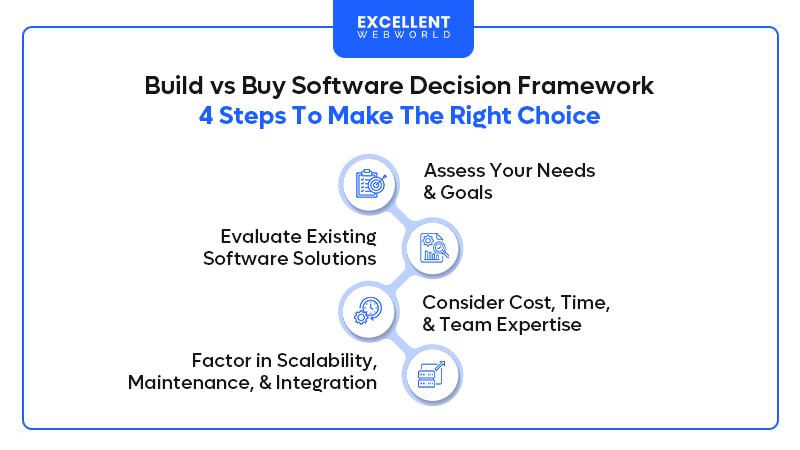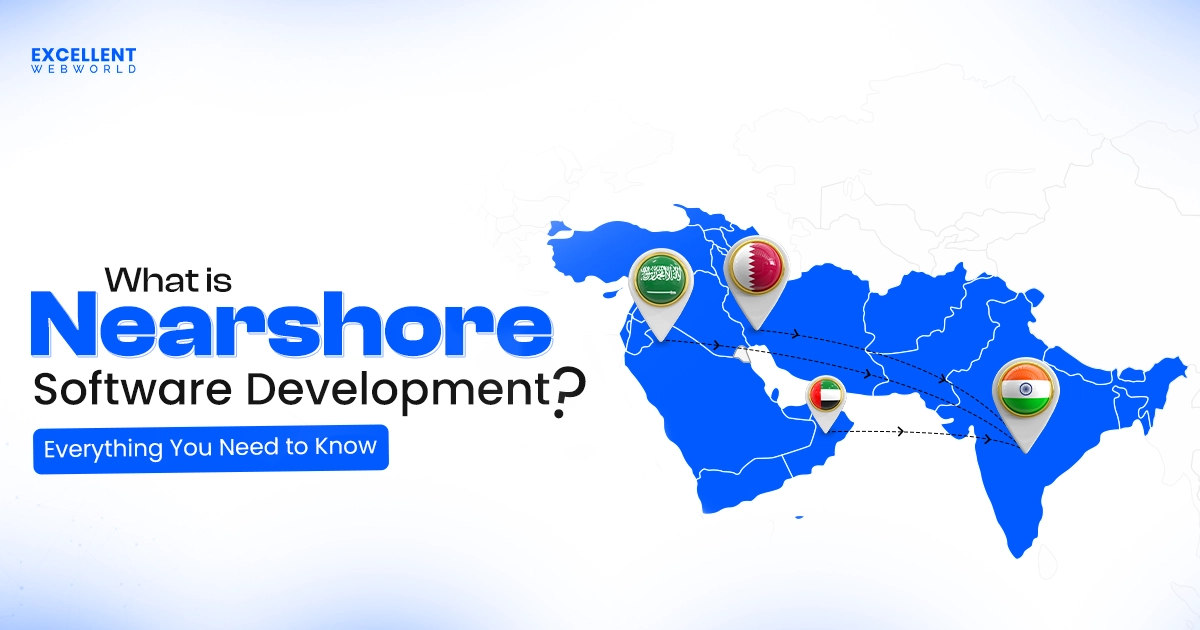Modern businesses constantly face challenges. These include automating workflows, improving analytics, enhancing team collaboration, and launching new digital products. Choosing the right software to address these needs, is a tough decision. There’s rarely a one solution that fits all needs.
That is where “Build vs Buy Software” dilemma comes into play. It brings forth the question: Should you build custom software tailored to your needs, or opt for off-the-shelf solution?
Making the right choice can significantly impact your company’s agility, costs, and long-term success. While performing build vs buy software analysis, several key questions naturally arise.
Key Questions for Software Decision-Making
With over 13 years of industry experience and certified expertise, we’ve guided over 900 organizations through complex software decisions. Our analysis in this guide will ensure you gain absolute clarity to choose the best approach. Now that we’ve highlighted our approach, let’s dive into What is Build vs Buy Software? to clarify these essential concepts.
What is Build vs Buy Software?
Build vs Buy Software means choosing between two paths, where businesses should pick either in-house or pre-built digital solutions. This involves decision-making based on different factors like cost, customization, deployment approaches, and ongoing support.
Let’s define what the build-and-buy software means for a simpler understanding.
With the right IT project management consulting, businesses can analyze these trade-offs more effectively, making strategic choices.
Key Factors to Consider When Building vs Buying a Software
Choosing between build vs buy software isn’t just a technical aspect; it’s a strategic one. Here are three factors that you should consider that impact your choice:
While thinking of buy vs build software analysis, custom software development with industry expertise & future-ready tech can transform your business, giving you a competitive advantage. By staying updated with the software development trends, you can easily make an informed and strategic decision.
You can check out the video below, where you will get to explore a visual journey that gives you a brief idea about the digital solutions, showcasing a custom-built solution across different industries like health tech, logistics, fintech, and more, benefiting the global business.
It also highlights the growing role of AI in software development, which changes how modern solutions are designed and coordinated. This shift is powered by an enhancement in AI-assisted software development, assisting teams to innovate faster and more effectively. Strategic, informed decisions that are backed by business IT consulting services are aligned with technology to establish the business’s long-term goals.
Now that you have understood what build vs buy software is, let’s explore the advantages & disadvantages.
What are the pros and cons of building vs buying software?
Understanding the build vs buy strategy is quite important while making your business. This directly affects the speed, cost, and scalability; thus, having an idea about the pros and cons can help you make the right decision.
Here’s a clear and simple breakdown of the pros and cons of build vs buy software.
Pros of Buying Software
Cons of Buying Software
Pros of Building Software
Cons of Building Software
Now that you have understood the pros and cons, let’s deep dive into the build vs buy decision framework.
Build vs Buy Software Decision Framework
So selecting between building and buying software is not about any technical decision, but it is a great strategic move.
The build vs buy software framework helps you evaluate key factors like cost, speed, scalability, and long-term ROI to make the perfect choice. As part of the evaluation, knowing the right software development frameworks is important.
A strong build vs buy analysis helps your software to align with the latest trends and also with future growth aspects.
With this four-step process, you will have a deeper understanding and a focused strategy that will guide you while choosing the right framework for your business.
Step 1: Assess Your Needs and Goals
Step 2: Evaluate Existing Software Solutions
Step 3: Consider Cost, Time, and Team Expertise
Step 4: Factor in Scalability, Maintenance, and Integration
This is where a build vs buy analysis template or a stronger build vs buy framework can help you with the build vs buy decision for long-term scalability and better clarity.
Real-World Examples: Build vs. Buy Software Case Studies & Insights
To help you visualize how businesses can make informed decisions or choices, let’s see a quick overview of real-world examples where organizations decide to build or buy software based on their aligned goals and the challenges.
1. Netflix Builds Own CDN (Control Over Performance)
Netflix chooses to build its own CDN, Open Connect, to gain more control over its video streaming services rather than relying on third-party providers like Akamai. As a result, this helps them to provide much greater performance with higher productivity.
Reason To Build: Increases Netflix’s scalability, provides greater control over applications, and improves user experience.
2. Slack buys AWS (Buying for Speed and Scale)
In the case of the product development space, Slack, in its earlier days, bought AWS services to build a scalable and reliable platform without managing all its infrastructure by itself. They leverage these off-the-shelf tools like AWS mainly for the third-party digital solutions and the infrastructure.
Reason To Buy: Buying AWS services helps the Slack platform focus on the collaboration process. astonishing growth rate, great responsiveness, and much higher reliability. It also allows them to avoid crash reports without much dependency on the IT management.
3. Uber’s Bold Shift to Own Map System (Built for Control and Reducing Dependency)
Now, Uber has shifted towards its map system along with third-party integrations such as Google Maps, which is different from earlier times. Once bought for navigation, it has now turned the tables with its own mapping solutions, codenamed Carbon, for the drivers to reduce dependency and have much greater control. Especially for the drivers, Uber has built a scalable & reliable driver interface as a newer version.
Reasons To Switch Build from Buy: This allows Uber to have cost controls, greater customization, and differentiating factors to distinguish itself from other players. It also allows them to have precise data about their needs in the app.
As we have covered all the aspects of build or buy software, now it’s time to wrap up everything, giving you the right decision.
Conclusion: Empowering Your Build vs. Buy Software Choice
So, selecting between building vs buying software comes with clarity, strategy, and proper alignment to the business. Utilizing a clear build vs buy decision framework can help you to assess the needs and trade-offs and also avoid overspending.
You can also see this quick checklist for a recap with these questions:
For stakeholder alignment, some of the strategic tips are
You can also make decision templates like build vs buy decision matrices, pros and cons analysis reports, and total cost of ownership calculation kinds of tools to deal with the complex things. These can be associated with the templates that ensure that your buy vs build analysis is driven appropriately. And when you think of choosing to build, having the right team is a key factor, so consider hiring dedicated developers to align technical things with the business goals.
At this particular stage of build vs buy software analysis, having the right development partner is what matters. With over a decade of experience guiding startups and enterprises with their crucial decisions, you can easily rely on us. Our experts even offer AI consultancy services that help businesses to leverage automation, have predictive analytics, and have scalable tech strategies.
Our team can help you to align product strategy with proper execution, whether you are thinking of building from scratch or buying off-the-shelf software, or even both. With our well-defined software development consulting process, you can have a seamless change with long-term success.
FAQs on the Build vs Buy Software Dilemma
You can break down the cost of ownership that involves maintenance, scaling, updates, and also team input over time for the comparison.
Some of the challenges or issues are a lack of clarity on future aspects, integration flexibility, and also mismatched expectations that affect the decision-making.
By analyzing scalability, integration flexibility, updates & support, and also how your system can evolve with the roadmap, it helps in the decision-making.
Custom-built systems are easier to modify when business priorities shift if the systems are designed for flexibility in the future. On the contrary, off-the-shelf products that are for immediate functionality often have challenges & costs for modification based on needs.
You should look for a transparent roadmap, regular updates, documentation, and a responsive team.
You can opt for APIs, middleware, and low-code platforms as strategies that simplify integration with the tech stack.
The custom solutions are the ones that give you control, while commercial software packages come with built-in features that meet legal compliance.
You should ask about the scalability, security, support, integration, and how they handle future aspects before making a final decision.
Yes, certain hybrid approaches let you customize features while leveraging the third-party tools.
So, buying software is quicker, which is about 1-2 weeks, while building software can take months.
You can track by analyzing the ROI through KPIs such as user adoption rate, time taken, revenue, and supported costs.

Article By
Paresh Sagar is the CEO of Excellent Webworld. He firmly believes in using technology to solve challenges. His dedication and attention to detail make him an expert in helping startups in different industries digitalize their businesses globally.




